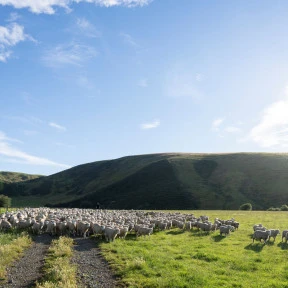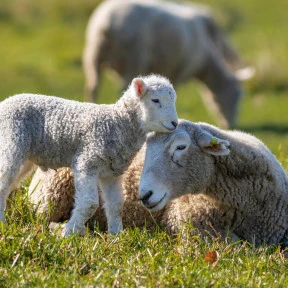Deferred grazing: Summer pasture management
‘Deferred grazing’ is a management tool to maintain pasture quality from mid-spring onwards. It involves dropping some paddocks out of the rotation to optimise grazing pressure on the remaining paddocks, so pasture quality is maintained. On a summer dry beef and sheep hill country farm northwest of Hamilton, it was estimated that deferred grazing on 15% of the farm increased total farm and per-hectare gross margins by 8% (FARMAX modelling). Deferred grazing is also a low risk and cheap tool to rejuvenate pastures.
Benefits of deferred grazing

Snapshots of a grazed (left) and deferred (right) section of a paddock on a beef and sheep farm northwest of Hamilton. Photos were taken in late autumn, three months after the deferred period ended.
Maintaining pasture quality over the whole farm:
By removing some paddocks from the grazing round, the stocking rate is increased over the rest of the farm. As a result, the spring feed surplus is better utilised and pasture quality is maintained.
Providing a feed wedge at the end of summer:
This avoids the cost and workload of buying and feeding out supplementary feed. A standing feed wedge available at the end of summer is particularly useful in drought years.
Increases pasture persistence:
Resting perennial ryegrass and other species from grazing from mid-spring until late summer / early autumn enables the desirable species to reseed and produce new plants in the following autumn. New tillers are also produced from the existing plants.
This leads to an increase in the tiller density of desirable pasture species and can increase pasture persistence.
An increase in clover populations after a long-deferred period:
Research from the 1950s in summer-moist hill country near Palmerston North showed that grazing pastures until late December to reduce ryegrass seed production, followed by resting pastures to allow white clover to flower and set seed, built up the clover seedbank and replenished energy reserves of existing clover plants. This led to an increase in the clover content in the pasture. Resting pastures from grazing from late December is much later than standard practice. If using deferred grazing to increase the clover content, note that the optimal timing of pasture rest will depend on the clover species.
Deferred pastures might look ugly before grazing but the result is outstanding and puts $$$ in your pocket.
How it works
In the deferred paddocks, perennial ryegrass produces seeds. New tiller buds that form at the base of existing plants remain dormant over summer and develop into new tillers in autumn. The deferred pastures are grazed to low residual levels at the end of the deferred period over one or two grazings (e.g. to 1500 kilograms of drymatter per hectare) so that the ryegrass seedlings and new ryegrass tillers are given access to light. They are treated as renewed pastures and are grazed carefully with light stock for short periods.
Find out more
Download the full guide
Deferred Grazing Handbook (pdf 8.6 MB)Project findings
In this project, AgResearch scientists compared deferred grazing to traditional rotational grazing in a field plot and split-paddock trials on three North Island sheep and beef hill country farms.
Compared to standard rotational grazing, deferred grazing improved pasture performance by increasing:
- Pasture quality at the farm scale
- Pasture production, ryegrass ground cover and tiller densities
- Topsoil moisture at the summer dry site
and reducing:
- Weed content
- Facial eczema spore count
Further investigation
This project has recently been awarded further funding through MPI's Sustainable Food and Fibre Futures Fund to investigate whether repeated application of deferred grazing over successive summers will result in larger and deeper root systems, increase water and nutrient use efficiency and overall pasture resilience in extreme climatic events.
More work is needed to quantify the effects of deferred grazing on:
- Roots under deferred pastures (mass, depth, changes over time)
- Soil carbon sequestration
- Environmental impacts (e.g. greenhouse gas emissions, effect on nitrogen leaching losses, phosphorus runoff and sediment losses from deferred pastures)
Paddock selection for deferred grazing
Grazing deferred pastures in autumn
The benefits of deferred grazing
Alert calendar
-
Deferred grazing alert calendar
Paddock selection (alert timing: August-September)
Criteria:
- Think of it like pasture renovation
- Address underlying issues (e.g. poor drainage, low fertility, major weed issues)
- Test your soil – has the paddock run out because of low pH / it is lacking in nutrients?
- If it is not performing well, do a herbage test to check for trace element deficiencies
- Which paddocks have taken a hit from summer drought or a wet winter?
- Select paddocks that contain high fertility pasture species (e.g. ryegrass and clover) and that are not overrun with weeds
- Keep a written record and a photo record of the paddock(s) you select
Shut the gate (alert timing: October)
- Monitor pasture cover so you know when a surplus is emerging
- Critical to let the ryegrass (or other desirable pasture species) flower and set seed
- Shut up at the same time as for silage (last hard graze in mid- to late-October, shut up in late October-November)
- Timing will depend on the year, paddock, pasture type and when the ryegrass begins to put up a seedhead
- If want to encourage clover, previous research suggests shut up the pastures to let the clover flower and set seed
- Hold your nerve and don’t look at the pasture until you are ready to graze it off!
- Don’t try and spray the weeds – likely to stress the clovers
Grazing off (alert timing: January)
- Make sure the seed has set
- Break feed the deferred paddock back into the grazing rotation with cattle or mob stock with either ewes or cattle.
- Be aware that pasture utilisation could be as low as 50%
Managing the regrowth (alert timing: March)
- Manage it like young grass
- Use the pull test for the first grazing
- Don’t let it get so long that the clover is suppressed
- If there is lots of clover, you may not need to apply N
- Graze with young stock rather than old stock
- Treat these paddocks like new pasture and graze them lightly again prior to winter
- Consider deferring different paddocks the following spring and repeat the above process
Recording your observations
Suggestions
- Keep a record of all the decisions: what was decided, when and why?
- Photos – take a range of photos and choose the best site from the first lot of photos
- Key times:
— Lock up— End January— Grazing off— Late autumn after the pastures are regrowing (eg late April / May)
- At each time:
— Take photos from the best position at different times (looking straight down as well as across the pasture— Make a 2-3 minute video on your phone showing the pasture and record your observations / thoughts— Use whatever method you normally use to assess pasture and livestock performance— What do the pastures look like?— How much ryegrass, clover and weeds?— What is the growth like?— What does it mean for livestock production?— Do the stock graze the pasture straight away or are they avoiding it (ie when grazing the deferred pasture and in the following autumn?)
- Assess pasture growth and livestock performance
— Use whatever method you normally use to assess pasture and livestock performance— Eg. pasture covers, liveweight gains, grazing days, stocking rate
Publications
Read our research
Deferred grazing researchProject partners
Funder
Beef + Lamb New ZealandFunder
OUR LAND AND WATERFunder
Ballance Agri-nutrientsFunder
Waikato Regional CouncilKey Projects
ResearchLatest News
NewsPasture Biotechnology update #3

Scientists Scott Knowles and David Hooks to grow high-performance materials in space

Bioeconomy Science Institute to research methane inhibitor for grazing livestock

New sheep trial aims to boost lamb survival and flock resilience
